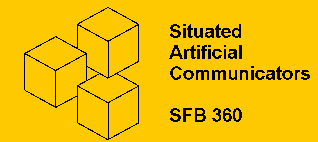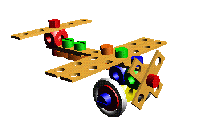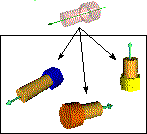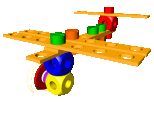University of Bielefeld -
Faculty of Technology -
Artificial Intelligence Group
 |
Conceptual Processing of Spatial
Perspectives and Construction Episodes |
 |
CODY ("Concept Dynamics") is a project in the Collaborative Research Centre
"Situated Artificial Communicators" (SFB 360) approved by the Deutsche
Forschungsgemeinschaft in 1993 and located at the University of
Bielefeld.  In an experimental setting of mechanical-object assembly, the CODY
project is concerned with the development of knowledge representations
and inference methods that are able to dynamically conceptualize the
situation in the task environment. A central aim is to enable an
artificial agent to understand and process natural-language instructions
of a human partner. Instructions may build on the current perception of
the assembly environment on the one hand, and on the other on the
knowledge-based understanding of grouped structures in the developing
construct. To this end, a dynamic conceptualization must integrate
information not only describing the types of the objects and aggregates
involved, but also their changing roles when becoming part of
structured assemblies.
In an experimental setting of mechanical-object assembly, the CODY
project is concerned with the development of knowledge representations
and inference methods that are able to dynamically conceptualize the
situation in the task environment. A central aim is to enable an
artificial agent to understand and process natural-language instructions
of a human partner. Instructions may build on the current perception of
the assembly environment on the one hand, and on the other on the
knowledge-based understanding of grouped structures in the developing
construct. To this end, a dynamic conceptualization must integrate
information not only describing the types of the objects and aggregates
involved, but also their changing roles when becoming part of
structured assemblies.
One of the main results of the first funding period (1993-1996) is the
development of an operational knowledge representation formalism, COAR, by which processes of dynamic conceptualization in
sequences of assembly steps can be formally reconstructed. Inferences
concern the assertion or retraction of aggregate representations in a
dynamic knowledge base, as well as the computation of role changes for
individual objects associated herewith. The structural representations
integrate situated spatial features and relations, such as position,
size, distance, or orthogonality, which are inferred on need from a
geometry description of the task environment.
 During the second funding period (1996 - 1999) a new type of imaginal
representations was developed. These imaginal
prototypes are parametric spatial representations of objects and
aggregates that capture - at different levels of abstraction - the
generic 3D shapes of structured mechanical objects. Furthermore, additional spatial
information, such as an object's intrinsic orientation, can be attached
to imaginal prototypes and inherited to all geometric instances in the
mechanical-object assembly environment. For example, the picture to the
left shows the inheritance of the spatial orientation of the imaginal
prototype of a bolt to three concrete bolts.
During the second funding period (1996 - 1999) a new type of imaginal
representations was developed. These imaginal
prototypes are parametric spatial representations of objects and
aggregates that capture - at different levels of abstraction - the
generic 3D shapes of structured mechanical objects. Furthermore, additional spatial
information, such as an object's intrinsic orientation, can be attached
to imaginal prototypes and inherited to all geometric instances in the
mechanical-object assembly environment. For example, the picture to the
left shows the inheritance of the spatial orientation of the imaginal
prototype of a bolt to three concrete bolts.
 In the third funding period (2000 - 2002) anticipation has been realized
as a facilitating feature in human computer interaction. Based on the
available knowledge about the object to build, the actual interpretation
of e.g. a wooden bar with three holes can be a propeller blade of an
aeroplane in one situation, and in another situation such a piece can be
part of the tail unit. The interpretation of a single part is always
done with respect to other as yet unassembled parts as well as those
parts already assembled to form an aggregate.
In the third funding period (2000 - 2002) anticipation has been realized
as a facilitating feature in human computer interaction. Based on the
available knowledge about the object to build, the actual interpretation
of e.g. a wooden bar with three holes can be a propeller blade of an
aeroplane in one situation, and in another situation such a piece can be
part of the tail unit. The interpretation of a single part is always
done with respect to other as yet unassembled parts as well as those
parts already assembled to form an aggregate.
 The fourth funding period (2003 - 2005) deals with another
aspect of anticipation. We now work on making construction episodes
available for the next level of user instructions. This is intended to
cope with instructions like "and now do the same thing on the other
side".
The fourth funding period (2003 - 2005) deals with another
aspect of anticipation. We now work on making construction episodes
available for the next level of user instructions. This is intended to
cope with instructions like "and now do the same thing on the other
side".
An artificial agent, MAX, takes on the role of a situated artificial communicator and interaction takes place in a fully immersive, large-scale virtual reality environment
. The evaluation of interaction metaphors as well as the
influence of the degree of immersion in virtual reality for various aspects
of spacial descriptions are subject to the cooperation with the
psycholinguistic part of this project.
project team:
Prof. Dr. Ipke Wachsmuth,
Ian Voss,
Dr. Stefan Kopp
student workers:
Marcel Richter,
Robert Neumann
cooperation with the psycholinguistic part of C1
Prof. Dr. Gert Rickheit, Helmut Flitter
demos:
see: VR Lab Showcase
project publications:
- I. Voss:
The Semantic of Episodes in Communication with the Anthropomorphic Interface Agent MAX.
In N.J. Nunes & C. Rich (eds.) Proceedings of IUI 2004. pp. 343-345, ACM Press, New York 2004
- I. Voss, I. Wachsmuth:
Extending Long-Term Knowledge on the Basis of Episodic Short-Term Knowledge.
In F. Schmalhofer & R. Young (eds.) Proceedings of the EuroCogSci03. p. 445,
Lawrence Erlbaum Associates, Publishers. London 2003
- T. Pfeiffer, I. Voss & M.E. Latoschik:
Resolution of Multimodal Object References using Conceptual Short Term Knowledge.
In F. Schmalhofer & R. Young (eds.) Proceedings of the EuroCogSci03. p. 426,
Lawrence Erlbaum Associates, Publishers. London 2003
- I. Voss:
Conceptualisation of Episodes in Interactive Virtual Construction.
In C. Stephanidis (ed.) HCI International 2003 Adjunct Proceedings. pp. 185-186,
Crete University Press, Heraklion June 2003
- I. Voss, I. Wachsmuth:
Anticipation in a VR-based Anthropomorphic Construction Assistant.
In J. Jacko & C. Stephanidis (eds.) Human - Computer Interaction, Theory and Practice (Part I) pp. 1283 - 1287,
Lawrence Erlbaum Associates, Publishers. London 2003
- I. Voß:
Gedächtnismodelle für die virtuelle Konstruktion in der
virtuellen Realität. In C. Vorwerg & I. Voß (eds.)
Gedächtnisprozesse in Interaktionen, pp. 41-46, SFB Report
03/02 , Universität
Bielefeld. 2002.
- I. Voss: Anticipation in construction dialogues. In J.
Vanderdonckt, A. Blandford & A. Derycke (eds.) "Interaction
without frontiers", Proceedings of Joint AFIHM-BCS Conference on
Human-Computer Interaction IHM-HCI'2001 (Lille, France, Sept.
2001), Vol. II, pp. 189-190, Cépaduès-Editions, Toulouse,
2001.
- C. Bauckhage, H. Rieser, B. Jung und I. Voß:
Struktur, Semiotik und Dynamik - ein Überblick über Aspekte und
Methoden der Modellierung mechanischer Aggregate. SFB 360 Report 01/01, Universität Bielefeld. Abstract.
- I.Wachsmuth, I. Voss, T. Sowa, M. Latoschik, S. Kopp & B. Jung:
Multimodale Interaktion in der Virtuellen Realität.
Mensch & Computer
(pp. 265-274), Stuttgart: Teubner, 2001.
- M. Hoffhenke & I. Wachsmuth: Object Recognition with Shape Prototypes in a 3D Construction Scenario. In W. Burgard, Th. Christaller & A. B. Cremers (Eds.), KI-99: Advances in Artificial Intelligence, Berlin: Springer (LNAI 1701), 1999, 231-242.
- M. Hoffhenke & I. Wachsmuth: Objektrepräsentation mit imaginalen Prototypen. In KogWis99: Proceedings der 4. Fachtagung der Gesellschaft für Kognitionswissenschaft, Bielefeld, 28. September - 1. Oktober 1999. Sankt Augustin: Infix, 1999, 292-293.
- B. Jung, M. Hoffhenke, B. Lenzmann & I. Wachsmuth: Interaktive Montagesimulation in virtuellen Umgebungen. Erschienen in H. Szczerbicka und T. Uthmann (Hrsg.): Modellierung, Simulation und Künstliche Intelligenz, Delft: SCS Euroean Publishing House, 2000, 193-210.
- K. Kessler, M. Hoffhenke, G. Rickheit & I. Wachsmuth: Dynamische Konzeptverarbeitung mit imaginalen und assoziativen Strukturen. In Kognitionswissenschaft, 8 (3), 1999, 115-122.
- M. Hoffhenke & I. Wachsmuth: Dynamische Konzeptualisierung mit imaginalen Prototypen. SFB 360 Report 97/9, Universität Bielefeld, 1998.
- B. Jung: Wissensverarbeitung für Montageaufgaben in virtuellen und realen Umgebungen. Dissertationen der Künstlichen Intelligenz, Bd. 157, Sankt Augustin: Infix, 1997.
- I. Wachsmuth & B. Jung: Dynamic Conceptualization in a Mechanical-Object
Assembly Environment, Artificial Intelligence Review, 10 (3-4) (pp 345-368).
Reprinted in P. Mc Kevitt (ed.): Integration of Natural Language and Vision Processing (Vol. IV), (pp. 191-214), Dordrecht: Kluwer, 1996.
- B. Jung, M. Hoffhenke, I. Wachsmuth:
Virtual Assembly with Construction Kits.
Presented at 1997 Design for Manufacturing Conference (DFM'97),
September 14-17, 1997, Sacramento, CA.
Appeared in Proceedings of the 1998 ASME Design for
Engineering Technical Conferences (DECT-DFM '98).
- B. Jung & I. Wachsmuth: Ein wissensbasiertes System für die
3D-computergraphische Montage-Simulation. In D. Ruland (ed.): Verteilte und
intelligente CAD-Systeme: Tagungsband CAD '96 (pp. 107-119), Bonn: Ges. für Informatik; Kaiserslautern/Saarbrücken: DFKI, 1996.
internal documents
Ian Voss,
03.08.2000. last modification: 19.03.2004




 In an experimental setting of mechanical-object assembly, the CODY
project is concerned with the development of knowledge representations
and inference methods that are able to dynamically conceptualize the
situation in the task environment. A central aim is to enable an
artificial agent to understand and process natural-language instructions
of a human partner. Instructions may build on the current perception of
the assembly environment on the one hand, and on the other on the
knowledge-based understanding of grouped structures in the developing
construct. To this end, a dynamic conceptualization must integrate
information not only describing the types of the objects and aggregates
involved, but also their changing roles when becoming part of
structured assemblies.
In an experimental setting of mechanical-object assembly, the CODY
project is concerned with the development of knowledge representations
and inference methods that are able to dynamically conceptualize the
situation in the task environment. A central aim is to enable an
artificial agent to understand and process natural-language instructions
of a human partner. Instructions may build on the current perception of
the assembly environment on the one hand, and on the other on the
knowledge-based understanding of grouped structures in the developing
construct. To this end, a dynamic conceptualization must integrate
information not only describing the types of the objects and aggregates
involved, but also their changing roles when becoming part of
structured assemblies.  During the second funding period (1996 - 1999) a new type of imaginal
representations was developed. These imaginal
prototypes are parametric spatial representations of objects and
aggregates that capture - at different levels of abstraction - the
generic 3D shapes of structured mechanical objects. Furthermore, additional spatial
information, such as an object's intrinsic orientation, can be attached
to imaginal prototypes and inherited to all geometric instances in the
mechanical-object assembly environment. For example, the picture to the
left shows the inheritance of the spatial orientation of the imaginal
prototype of a bolt to three concrete bolts.
During the second funding period (1996 - 1999) a new type of imaginal
representations was developed. These imaginal
prototypes are parametric spatial representations of objects and
aggregates that capture - at different levels of abstraction - the
generic 3D shapes of structured mechanical objects. Furthermore, additional spatial
information, such as an object's intrinsic orientation, can be attached
to imaginal prototypes and inherited to all geometric instances in the
mechanical-object assembly environment. For example, the picture to the
left shows the inheritance of the spatial orientation of the imaginal
prototype of a bolt to three concrete bolts.
 In the third funding period (2000 - 2002) anticipation has been realized
as a facilitating feature in human computer interaction. Based on the
available knowledge about the object to build, the actual interpretation
of e.g. a wooden bar with three holes can be a propeller blade of an
aeroplane in one situation, and in another situation such a piece can be
part of the tail unit. The interpretation of a single part is always
done with respect to other as yet unassembled parts as well as those
parts already assembled to form an aggregate.
In the third funding period (2000 - 2002) anticipation has been realized
as a facilitating feature in human computer interaction. Based on the
available knowledge about the object to build, the actual interpretation
of e.g. a wooden bar with three holes can be a propeller blade of an
aeroplane in one situation, and in another situation such a piece can be
part of the tail unit. The interpretation of a single part is always
done with respect to other as yet unassembled parts as well as those
parts already assembled to form an aggregate.
 The fourth funding period (2003 - 2005) deals with another
aspect of anticipation. We now work on making construction episodes
available for the next level of user instructions. This is intended to
cope with instructions like "and now do the same thing on the other
side".
The fourth funding period (2003 - 2005) deals with another
aspect of anticipation. We now work on making construction episodes
available for the next level of user instructions. This is intended to
cope with instructions like "and now do the same thing on the other
side".